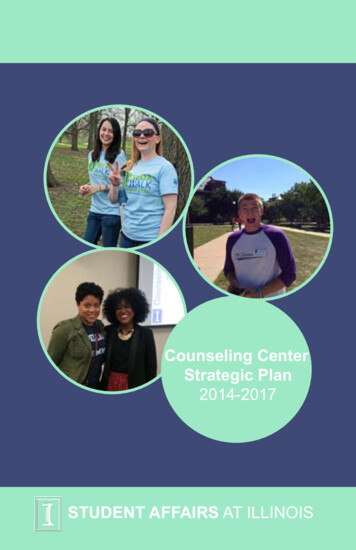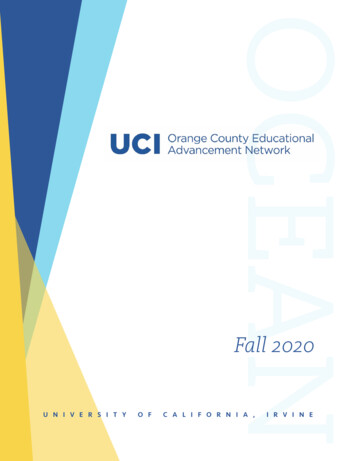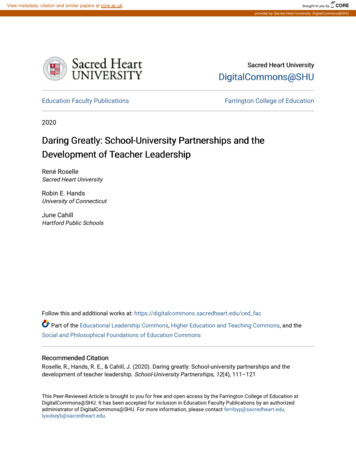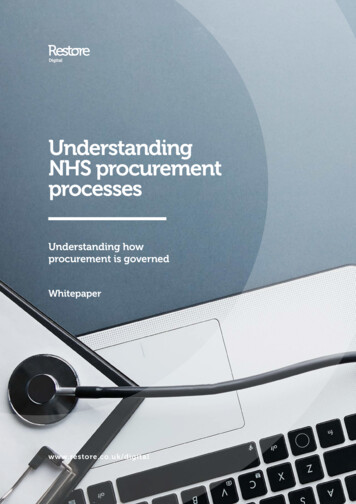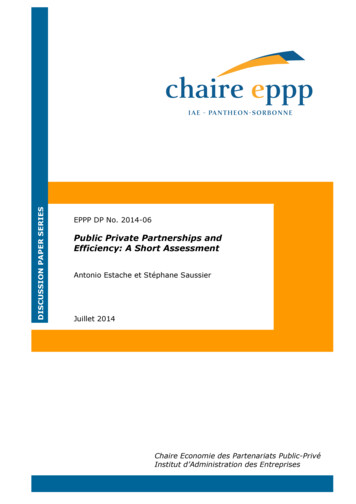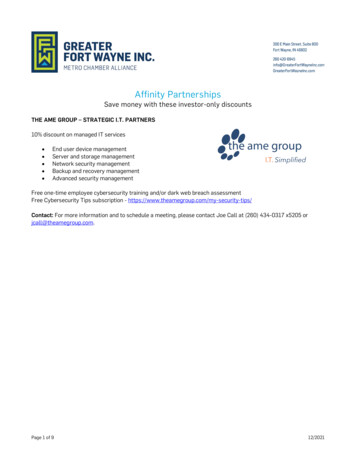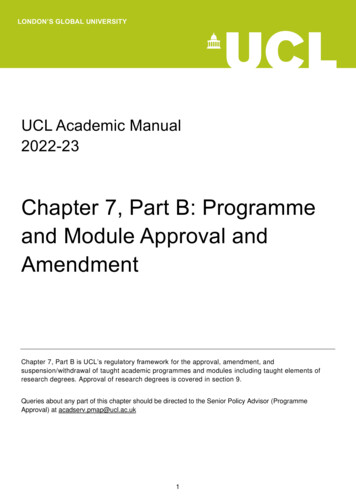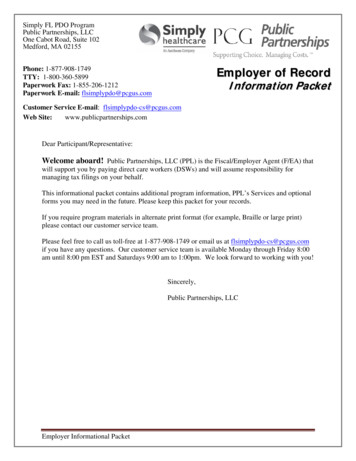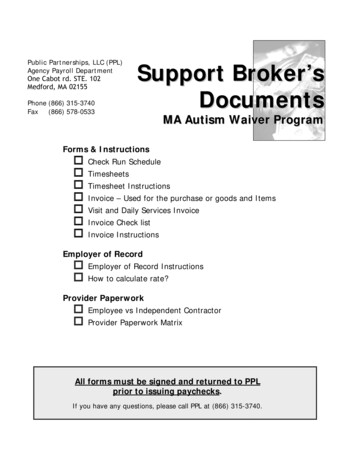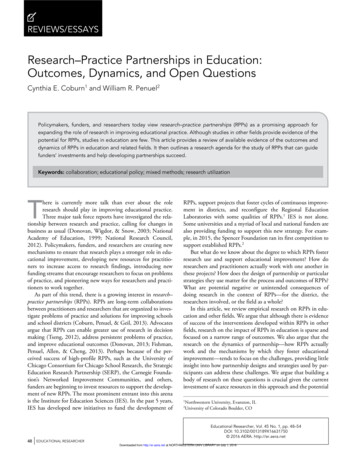
Transcription
631750Educational ResearcherMonth XXXReviews/EssaysResearch–Practice Partnerships in Education:Outcomes, Dynamics, and Open QuestionsCynthia E. Coburn1 and William R. Penuel2Policymakers, funders, and researchers today view research–practice partnerships (RPPs) as a promising approach forexpanding the role of research in improving educational practice. Although studies in other fields provide evidence of thepotential for RPPs, studies in education are few. This article provides a review of available evidence of the outcomes anddynamics of RPPs in education and related fields. It then outlines a research agenda for the study of RPPs that can guidefunders’ investments and help developing partnerships succeed.Keywords: collaboration; educational policy; mixed methods; research utilizationThere is currently more talk than ever about the roleresearch should play in improving educational practice.Three major task force reports have investigated the relationship between research and practice, calling for changes inbusiness as usual (Donovan, Wigdor, & Snow, 2003; NationalAcademy of Education, 1999; National Research Council,2012). Policymakers, funders, and researchers are creating newmechanisms to ensure that research plays a stronger role in educational improvement, developing new resources for practitioners to increase access to research findings, introducing newfunding streams that encourage researchers to focus on problemsof practice, and pioneering new ways for researchers and practitioners to work together.As part of this trend, there is a growing interest in research–practice partnerships (RPPs). RPPs are long-term collaborationsbetween practitioners and researchers that are organized to investigate problems of practice and solutions for improving schoolsand school districts (Coburn, Penuel, & Geil, 2013). Advocatesargue that RPPs can enable greater use of research in decisionmaking (Tseng, 2012), address persistent problems of practice,and improve educational outcomes (Donovan, 2013; Fishman,Penuel, Allen, & Cheng, 2013). Perhaps because of the perceived success of high-profile RPPs, such as the University ofChicago Consortium for Chicago School Research, the StrategicEducation Research Partnership (SERP), the Carnegie Founda tion’s Networked Improvement Communities, and others,funders are beginning to invest resources to support the development of new RPPs. The most prominent entrant into this arenais the Institute for Education Sciences (IES). In the past 5 years,IES has developed new initiatives to fund the development of48 EDUCATIONAL RESEARCHERRPPs, support projects that foster cycles of continuous improvement in districts, and reconfigure the Regional EducationLaboratories with some qualities of RPPs.1 IES is not alone.Some universities and a myriad of local and national funders arealso providing funding to support this new strategy. For example, in 2015, the Spencer Foundation ran its first competition tosupport established RPPs.2But what do we know about the degree to which RPPs fosterresearch use and support educational improvement? How doresearchers and practitioners actually work with one another inthese projects? How does the design of partnership or particularstrategies they use matter for the process and outcomes of RPPs?What are potential negative or unintended consequences ofdoing research in the context of RPPs—for the district, theresearchers involved, or the field as a whole?In this article, we review empirical research on RPPs in education and other fields. We argue that although there is evidenceof success of the interventions developed within RPPs in otherfields, research on the impact of RPPs in education is sparse andfocused on a narrow range of outcomes. We also argue that theresearch on the dynamics of partnership—how RPPs actuallywork and the mechanisms by which they foster educationalimprovement—tends to focus on the challenges, providing littleinsight into how partnership designs and strategies used by participants can address these challenges. We argue that building abody of research on these questions is crucial given the currentinvestment of scarce resources in this approach and the potential1Northwestern University, Evanston, ILUniversity of Colorado Boulder, CO2Educational Researcher, Vol. 45 No. 1, pp. 48 –54DOI: 10.3102/0013189X16631750 2016 AERA. http://er.aera.netDownloaded from http://er.aera.net at NORTHWESTERN UNIV LIBRARY on July 1, 2016
for assisting newly funded partnerships. We close by framing aresearch agenda for investigating RPPs as a strategy for improving U.S. public schools.What Are RPPs?The term partnership is used widely in U.S. education to refer toa broad range of arrangements between researchers and practitioners, such as consulting agreements, use of schools or districtsas places to test university-developed innovations, and sites forteacher training and internships. RPPs are a very specific form ofpartnership. They are long term—rather than being focused ona single study, researchers and system leaders share an openended commitment to build and sustain a working collaborationover multiple projects. Rather than developing studies thataddress gaps in existing theory or research, they focus on problems of practice—key dilemmas and challenges that practitioners face. They are mutualistic—the focus of the work is jointlynegotiated and there is shared authority. RPPs employ intentional strategies to foster partnerships, with carefully designedrules, roles, routines, and protocols that structure interaction.Finally, they involve original analysis of data—participants collect their own and sometimes use sophisticated analytic techniques to answer districts’ questions using administrative data(Coburn et al., 2013).RPPs can involve different types of partners and focus on awide variety of problems of practice. Some RPPs form betweenresearchers and leaders in a single district; others form amongresearchers, schools, and other youth-serving agencies in a region.Still others comprise networks of geographically distributed institutions, such as community colleges or school districts. Some areinitiated by researchers, others by practitioners (e.g., Cooper,2007; Penuel, Coburn, & Gallagher, 2013), and still others byfunders. RPPs can focus on doing independent analyses of district policies and their implementation, providing findings toeducational decision makers, and working with them to developsolutions (e.g., Research Alliance for New York City Schools).They can involve researchers and practitioners codesigning andtesting solutions for improving teaching and learning or orchestrating systemwide change (e.g., Middle-School Mathematicsand the Institutional Setting of Teaching; Cobb, Jackson, Smith,Sorum, & Henrick, 2013). They can also involve systematicmethods for fostering continuous improvement research amongnetworks of schools, districts, or other institutions (e.g., Bryk,Gomez, Grunow, & LeMahieu, 2015). Some focus on in-schooland out-of-school spaces and the connections between them(e.g., the John W. Gardner Center for Youth and TheirCommunities), whereas others focus on issues of policy and practice within public schools. Some involve university researchers(e.g., Stanford University/San Francisco Unified School DistrictPartnership), whereas others involve researchers in intermediaryorganizations (SERP; Donovan, 2013). RPPs of all types are currently proliferating, fueled by increased interest from local andnational funders but also by researchers’ and practitioners’ desireto find new models of research that make a difference in publicschools in more tangible ways. But what do we know about whenand under what conditions RPPs make a difference in schoolsand school districts?What Do We Know About the Outcomesof RPPs?Most research on the outcomes of RPPs in education and otherfields has focused on the impact of interventions developed inthe context of a partnership. Thus, they do not investigate theimpact of the partnership itself or other outcomes of RPPs.Our review of the literature detailed below suggests that manyinterventions developed in the context of partnerships have shownpositive outcomes. While there are quite a few studies of the outcomes of RPP in education, many more come from fields as diverseas public health, mental health, and criminology. However, theresearch is relevant for education because the partnerships have features similar to those in education. They are long term, mutualistic,and focused on collaboratively defined problems of practice (Kinget al., 2010; Metzler et al., 2003). In addition, these fields involveprofessionals whose work, like the work of teachers, focuses onchanging people’s thinking and behavior (Cohen, 2011).In public health, RPPs can involve multiple organizationsthat serve community members working alongside researchers todevelop and test interventions collaboratively (e.g., Bullock,Morris, & Atwell, 2011; Israel, Schulz, Parker, & Becker, 1998;Wallerstein & Duran, 2010). For example, in the CommunitiesThat Care (CTC) model, researchers work with multiagencycollaboratives to assess needs and then select and implementevidence-based programs in primary prevention for adolescentsto meet those needs. The model aims to build a culture of evidence-based decision making and commitment to primaryprevention across a community.Researchers tested whether the CTC model can help buildsuch a culture and produce positive impacts on youth development outcomes in a large-scale, cross-community randomizedcontrolled trial. They found that leaders in communities thatformed partnerships with researchers to implement CTC weremore likely to devote resources to primary prevention than incomparison communities (Brown, Hawkins, Arthur, Briney, &Fagan, 2011). They also found positive impacts on youth inCTC, documenting lower levels of alcohol and cigarette use andfewer delinquent behaviors compared to youth in control communities (Hawkins et al., 2008, 2009).In the field of mental health, one RPP composed of socialservice providers, parents, and researchers developed and testedinterventions that targeted behavior of elementary school–ageyouth (Garland, Plemmons, & Koontz, 2006; Horsfall, Cleary,& Hunt, 2011; Kazak et al., 2010). Researchers studied theimpact of an intervention called Multiple Family Groups thatsought to reduce parenting stress and children’s oppositionalbehavior. The protocols were iteratively refined over multiplesessions based on input from stakeholders and evidence frompilot studies (see McKay et al., 2010, for descriptions). Arandom- assignment study found the protocol for the intervention was successful in reducing parent reports of children’soppositional behavior and reducing parents’ stress (McKayet al., 2011). Another partnership formed to support care forinfants and toddlers at risk for autism spectrum disorders foundthat the collaboratively designed efforts to enhance evidencebased practice resulted in improvements in child communication and engagement and enhanced parent skills to supportJANUARY/FEBRUARY 2016 49Downloaded from http://er.aera.net at NORTHWESTERN UNIV LIBRARY on July 1, 2016
children’s development (Brookman-Frazee, Stahmer, Lewis,Feder, & Reed, 2012).In criminology, there have been multiple RPPs focused oncommunity policing, in part due to strong federal supportthrough such programs as the National Institute of Justice’sBuilding and Enhancing Criminal Justice Researcher–PractitionerPartnerships initiative.3 One partnership that has been studiedextensively focuses on reducing gang violence in Boston.Researchers facilitated the use of data by the police department todefine the scope of the problem, helped develop response efforts,and evaluated those efforts (Braga, Kennedy, & Tita, 2002). Theyfound that this approach reduced overall levels of youth violence,including when compared to trends in similar cities (Braga,Kennedy, Waring, & Piehl, 2001).Research on the efficacy of interventions developed by RPPs ineducation also has, by and large, found promising impacts on studentlearning (e.g., Barab, Gresalfi, & Ingram-Goble, 2010; Booth et al.,2015; Fishman, Marx, Best, & Tal, 2003; Geier et al., 2008; Penuelet al., in press; Snow, Lawrence, & White, 2009; Yarnall, Shechtman,& Penuel, 2006). For example, Word Generation, an interventiondeveloped as part of SERP that targets middle school students’ academic language, has strong evidence of efficacy from a randomizedcontrolled trial (Snow et al., 2009). A recent collaboration betweenSERP and district members of the Minority Student AchievementNetwork developed and tested an intervention in algebra. A randomassignment study found the intervention to be successful in improving students’ conceptual understanding in mathematics (Booth et al.,2015). Comparison group and randomized controlled studies ofinnovative science curriculum units developed by RPPs have alsoshown promise for improving student learning on standardized tests(e.g., Geier et al., 2008) and researcher-designed measures (e.g., Barabet al., 2010; Penuel et al., in press). Other research has documentedpositive effects of interventions developed by partnerships on teachingand assessment practice (e.g., Yarnall et al., 2006) and on curriculumimplementation (e.g., Fishman et al., 2003).However, there are myriad interventions developed in thecontext of RPPs in education and other fields that have not beensubject to systematic inquiry. Furthermore, we do not knowwhether these results would be different if the intervention wasdeveloped outside the context of a RPP. And, importantly, thesestudies do not address the value of the partnerships themselves,above and beyond the particular innovations they produce.There are a handful of studies that investigate the influence ofthe partnerships themselves. Several studies provide evidencethat participation in partnerships is associated with greater accessto research (Bickel & Cooley, 1985; Kerr, Marsh, Ikemoto,Darilek, & Barney, 2006). However, there is mixed evidenceabout whether participation in partnerships is associated withincreased use of this research for making decisions, with somestudies showing extensive use (Allensworth, 2015), others showing limited use (Coburn, Toure, & Yamashita, 2009), and stillothers showing that research use varied within and between districts (Honig, Venkateswaran, McNeil, & Twitchell, 2014;Hubbard, 2010). In addition, with the exception of Honig andher colleagues (2014), these studies are single case studies ofpartnerships, making it difficult to investigate how differentstrategies used by researchers in the context of partnerships ordifferent contexts influence use.Many other potential outcomes of RPPs remain unexplored.Advocates argue that collaborative design in RPPs can lead tomore usable interventions, which in turn can foster scale-up andsustainability (Anderson & Shattuck, 2012). Although someresearch reports on teachers’ perceptions of the usability of particular tools (e.g., Booth et al., 2015), we know of little systematic research on whether and how participation in codesigninfluences the degree to which districts adopt, scale, and sustainthe innovations they help produce. Building the capacity of educational systems to engage in research-informed improvementefforts is another goal of RPPs (Bryk et al., 2015). But existingresearch has not investigated whether participation builds adeeper understanding of the research process or research findings, an appreciation for the value of research to inform decisionmaking, or capacity to engage in research-informed practicesand policies or use research as part of continuous improvementefforts. Finally, we know little about unintended outcomes ofRPPs, for example, if efforts may sour practitioners’ views of thevalue of research if researchers produce findings that are contraryto their beliefs, fail to produce research in a timely manner, orhave difficulty securing funding for the long term (see Cousins& Simon, 1996, on this last point).What Do We Know About the Dynamics of RPPs?There is a bit more research on the dynamics of partnerships:how they actually work and the mechanisms by which they foster educational improvement. The vast majority of this work isfirst-person reflections written by researchers (rarely practitioners) who are participants in partnerships (e.g., Roderick,Easton, & Sebring, 2007, but see Cooper, 2007, for an exception). These insider accounts often describe strategies that partnerships employ for organizing their work and learning fromone another (e.g., Edwards, 2011). As such, they provide insightinto the workings of RPPs that others may use to inform theirwork. However, these accounts do not derive from systematicresearch design, data collection, and analysis. They also typicallyinvolve retrospective analyses, making them subject to hindsightbias. Outside researchers may have a greater ability to probe,surface, and report on perspectives and experiences of the fullrange of participants. They are more likely to be able to studypartnerships in real time, thus avoiding bias introduced in retrospective analysis. And they have a greater ability to engage incomparative research across multiple partnerships.There is a small body of research conducted by outsideresearchers on RPPs. This work largely focuses on the challenges(e.g., Coburn, 2010; Firestone & Fisler, 2002; Heckman, 1988;Penuel, Roschelle, & Shechtman, 2007; Vozzo & McFadden,2001). For example, existing research highlights the difficultiesthat researchers and practitioners have communicating becausethey lack a common language with which to talk about issuesfacing practitioners (e.g., Sirotnik & Goodlad, 1998). Otherstudies demonstrate how RPPs depend upon atypical norms ofinteraction and new roles and responsibilities that are oftenunfamiliar to both researchers and practitioners (Coburn, Bae,& Turner, 2008). Differences in expectations regarding norms,roles, and responsibilities can lead to confusion, uncertainty, andeven conflict (Coburn et al., 2008; Rosen, 2010).50 EDUCATIONAL RESEARCHERDownloaded from http://er.aera.net at NORTHWESTERN UNIV LIBRARY on July 1, 2016
Studies of the dynamics of partnership have also documenteda range of challenges stemming from the organizational realitiesof educational systems. For example, school districts have complex organizational structures, with multiple divisions and multiple levels. This structure tends to foster the development ofdifferent points of view as those in different parts of the districthave different disciplinary backgrounds, work roles, and waysthat they focus their attention (Coburn et al., 2009; Spillane,1998). This raises questions about whom in the district oneshould partner with and how to coordinate across multiple goalsand agendas that are present in the district (Coburn & Stein,2010). Turnover is also endemic, especially at upper levels of thesystem. When key staff turn over, new relationships must beformed, trust rebuilt, and work routines and understandingsestablished. Change in leadership may also come with new goalsand priorities that require the direction of joint work to be renegotiated (Rosenquist, Henrick, & Smith, 2015).Finally, research has highlighted the degree to which RPPsexist in highly politicized environments (Scott, Lubienski,DeBray, & Jabbar, 2014). Multiple interest groups inside andoutside the district pressure district administrators to make particular decisions (Englert, Kean, & Scribner, 1977). This researchsuggests that RPPs do not exist apart from these pressures, andthey must learn to navigate the complex and shifting politicalcontexts of school districts.Although research on RPPs from outside researchers identifies no shortage of challenges, we know little about the extent towhich the strategies that participants document in their firstperson accounts are effective at addressing challenges (D’Amico,2010, is an exception). At present, there is little basis for recommending some partnership designs or particular strategies toaddress challenges over others. Furthermore, studies of RPPs ineducation and other fields tend to investigate either the dynamics of partnerships or their outcomes but not both. For this reason, we have little insight into the mechanisms by which RPPsfoster the full range of intended and unintended outcomes.In light of the rather large holes in the existing knowledge baseon RPPs, we believe that it is time for a more focused researcheffort on the process and outcomes of RPPs. This research isnecessary to assess the impact of not only funders’ investmentsbut also the time that researchers and practitioners are investingin this work. It is also necessary to inform the growing numberof researchers and practitioners who are involved in these partnerships, providing information about when and under whatconditions different partnership strategies bear fruit. Further more, research in this realm could help researchers and practitioners new to this work learn the skills, strategies, roles, andidentities that may be necessary to do it well. Here, we outlineareas of focus that may help address these needs of policymakersand partnership participants.the assumption that partnerships can help improve outcomes forstudents. Research is needed to investigate whether this is truefor a wider range of partnerships, for a wider range of innovations they create, and for partnership activities beyond codesign(e.g., research on district policies or practices, continuous impro ve ment structures). Given long time frames, this task requiresthe development of appropriate metrics to judge the early progress of partnerships, well before student outcomes are likely to beaffected.We also need studies that investigate other outcomes of RPPs,including individual and organizational change, research use,and spread and scale of innovation. For example, studies of RPPsthat focus on codesign should also focus on the impact of thedesign and development process on beliefs and practices ofteachers, researchers, and district leaders who participate. Suchstudies are important because they can shed light on whetherand how the process itself contributes to improved student outcomes through changes in beliefs and practices of adults whoimplement them. In addition, advocates argue that participationin RPPs fosters greater understanding of the research process andgreater use of research by school and district leaders in their decision making. The small handful of existing studies find mixedresults here. We need to better understand when and under whatconditions RPPs foster research use and when they do not.Crucially, we need studies that attend to unintended or negative outcomes. For example, critics of RPPs argue that the resultsof studies done in specific contexts are not generalizable (Kelly,2004) or are focused on only a narrow range of important issues.They argue that although the research may inform a specific district, it may not contribute to educational improvement morebroadly. Some (not all) RPPs do seek to design tools and conductresearch that informs the wider field (e.g., Donovan et al., 2003).We need studies that investigate whether they accomplish theseaims. Other critics express concern that researchers who workclosely with the districts they study lose their objectivity(Anderson & Shattuck, 2012; Kelly, 2004) and that findings maynot go through peer review, with the potential to lead districtsand the field astray. We also need studies that investigate theseclaims as well as studies that are attentive to other negative orunintended outcomes. This information is crucial in understanding the degree to which investments in RPPs are bearing fruit.The field would also benefit from studies that investigatefailed partnerships. Existing research and writing largely focuson partnerships that are perceived to be successful. But manypartnerships fail to get off the ground in the first place, and others fail to be sustained over the long term (Penuel et al., 2013).It is only by investigating multiple partnerships with differentlevels of performance that we will begin to understand when andunder what conditions RPPs develop into productive partnerships, are sustained, and meet their goals. Findings from suchstudies can also inform criteria funders use to judge whether proposed partnerships have in place needed supports to launch jointwork productively.OutcomesComparative StudiesWe need to learn more about the consequences of RPPs. Manyfunders are making significant investments in partnerships withWe need comparative studies that investigate how RPPs of different designs interact with their contexts to impact various outcomesResearch Agenda for RPPsJANUARY/FEBRUARY 2016 51Downloaded from http://er.aera.net at NORTHWESTERN UNIV LIBRARY on July 1, 2016
of interest. RPPs vary quite a bit in their designs, providing a greatopportunity to uncover how partnership design matters for the fullrange of relevant outcomes. For example, some partnershipsemphasize maintaining researcher independence.4 In these RPPs,researchers engage with practitioners at the front end to developideas for study and at the tail end when they have results (Rodericket al., 2007). By contrast, other RPPs involve codesign of interventions or ongoing researcher engagement in district problem solving. How do these varying strategies impact research use? It is likelythat any partnership design involves trade-offs, and comparativestudies of partnerships with similar aims but different designs couldhelp to illuminate those trade-offs.Targeted Studies of StrategiesWe need targeted studies of specific strategies that partnershipsuse. Existing research tends to focus on the challenges, providinglittle insight into how tools, strategies, and routines used by participants address these challenges. Studies could investigate therelative strengths and weaknesses of strategies for addressingsuch common challenges as persistent turnover, the need to create shared language or work practices, fostering trust, and waysto work with and across multiple levels of educational systems.They could investigate if and how it matters if partnerships orspecific lines of work are initiated by the district, by researchers,or by funders. This knowledge is important given increasedfunding initiatives that support new RPPs, bringing researchersand practitioners who have little experience in building or sustaining partnerships into the work. Furthermore, it is critical, ifwe are to move beyond the exhortation that building partnerships between researchers and practitioners is hard, to understand the relative efficacy of different approaches for addressingchallenges.Political Dimensions of PartnershipsFinally, we need studies that examine the political dimensions ofpartnerships. Many researchers believe that politics gets in theway of effective research use and hope that producing higherquality research will assist districts in moving decisions out of thepolitical realm (see, e.g., Haskins & Baron, 2011). Few studies ofRPPs address these concerns. Given evidence that research isoften born out of and feeds back into political struggles anddebates in central ways (Henig, 2012; Lubienski, Scott, &DeBray, 2014), it is important that we understand the role thatRPPs play in the political context of the district as well as strategies for navigating the politics such that partnerships can continue to help districts address their critical needs.ConclusionGiven new investments in RPPs, we need parallel investments inresearch on the dynamics and outcomes of partnerships. Studiesof partnership dynamics are crucial to enable new partnershipsto learn how to do this work and for existing partnerships tolearn from each other’s experiences. Research on an expanded setof outcomes for RPPs—negative as well as positive—can helpfunders and partnerships alike gain a better sense early on as towhether their partnerships are likely to lead to improvements instudent achievement and other outcomes. With a broader evidence base in both the dynamics and outcomes of RPPs, we candevelop a better sense of whether, when, and how RPPs are aviable and effective way for research to support broad and sustainable improvements to educational systems.NotesWe thank Kimberly Geil for her contributions to identifying literature for this review. We also gratefully acknowledge Caitlin Farrell andAnna-Ruth Allen. Their collaboration on an ongoing study of research–practice partnerships has greatly influenced our thinking about partnerships. We also thank Natalie Jou for administrative assistance. Thismaterial is based in part on research funded by the William T. GrantFoundation. Any opinions, findings, conclusions, or recommendationsexpressed in this material are those of the authors and do not necessarilyreflect the views of the funder.1For information about the Institute for Education Science’sResearcher Practitioner Partnership in Educational Research program,see http://ies.ed.gov/funding/ncer rfas/partnerships.asp. For information about its Continuous Improvement in Educational Research program, see http://ies.ed.gov/funding/ncer rfas/cir.asp.2See ts.3See One strategy for maintaining independence while also fosteringpartnership is to provide districts with the opportunity to review andcomment on research findings in advance of publication (Roderick,Easton, & Sebring, 2007). Most research–practice partnerships followthis practice, but there are a select few that allow partners to review andapprove findings as a way to show a commitment to mutualism andbuild trust. It would be useful to investigate if and how these differentpractices impact the nature of the research that is don
2University of Colorado Boulder, CO Research-Practice Partnerships in Education: Outcomes, Dynamics, and Open Questions Cynthia E. Coburn1 and William R. Penuel2 Policymakers, funders, and researchers today view research-practice partnerships (RPPs) as a promising approach for expanding the role of research in improving educational practice.

